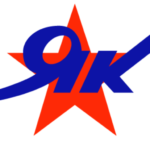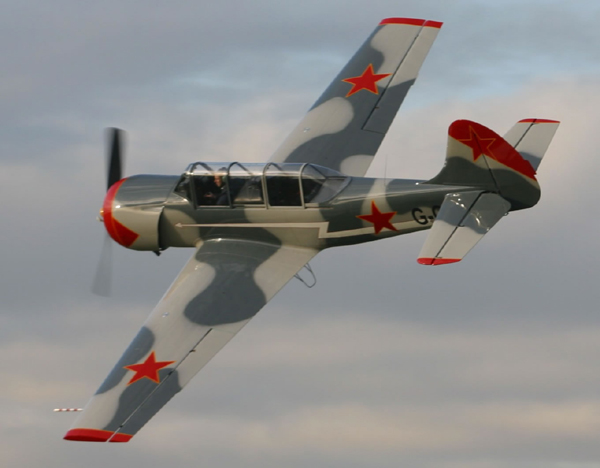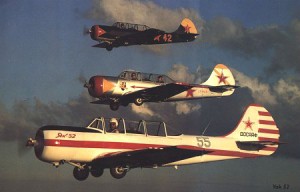Typical Overhauled YAK 52 Specifications
| Date of airframe manufacture: | 1980-89 some examples made to 1996 |
| Date of engine manufacture: | 1980-89 |
| Total time on engine at overhaul: | 500-700 Hours |
| Total time of airframe at last overhaul: | varies from 1000 – 2000 Hours |
| Registration: | British or Lithuanian, Civil. With military history provided (Important for UK CAA approval) |
The airframe and engine overhaul consists of a nose to tail total disassemble and checking. General overhaul information, and pictures of O/H facilities The airframe is corrosion proofed during manufacture by anodizing, and also etch/epoxy priming internally.
Instruments include standard flight and engine instruments in addition to the fully aerobatic horizon, magnetic slaved gyro compass and combined VSI/Turn and Slip. The slaved gyro compass is combined with a 8 channel, ground tunable ADF. The instruments are very good and are easy to use in IFR conditions. The aircraft is not airways equipped, having a single altimeter as standard. Most owners will fit a GPS.
Both cockpits have full duplication of instruments and controls, with the exception of gills control and manifold pressure gauge. The aircraft is flown solo from the front cockpit, the instructor occupies the rear seat. The rudder pedals are adjustable in both cockpits. The cockpit heating and ambient ventilation is very good in both cockpits. The aircraft was designed to operate in temperatures from -20°C to +40°C.
A 720 channel radio is fitted along with an intercom; the radio is compatible with David Clark headsets. The radio specifications exceed the requirements for western airlines. 0.001 frequency stability.
Flight Details and Performance
The aircraft is stressed to +7 & -5 G, with full fuel and two crew. It is equipped with full inverted fuel and oil systems. A vertical flick roll with two pilots is easily possible.
| Speeds: | VNE | 450 kph | |
| 75% cruise | 245 kph | Fuel consumption 65 litres per hour | |
| 70% cruise | 230 kph | 60 litres per hour | |
| 60% cruise | 200 kph | 46 litres per hour |
- The initial rate of climb is 1850 FPM, with 2 crew and full fuel.
- Take off run is 170 meters (start to wheels off)
- Landing run is 200 meters (wheels down to stop, approach speed 130 kph)
- The control forces are light and the aircraft is responsive, and is suitable for low houred pilots and experienced aerobatics pilots alike, offering great enjoyment.
| YAK – 52 data sheet. | (data below is the results of actual flight testing) |
| 1. PRODUCT NAME; YAK-52 | |
| 2. DEVELOPMENT BASIS: |
| 4. DESTINATION AND FIELD OF APPLICATION |
| The YAK-52 aircraft is designed for civil aviation use and in the standard design is intended for the following missions: |
| o Flight instruction |
| o Aerobatic training and competition |
| o Pleasure flying |
| o Airshow flying |
| o Air combat sorties (ACM) |
Optional equipment may be fitted on the aircraft according to customer specifications. eg smoke systems, 400 hp, MT propeller, rounded wing tips, strobe/ nav lights etc.
5. AIRCRAFT CHARACTERISTICS AND PERFORMANCES
5.1. The characteristics and performance of the YAK-52 aircraft have been chosen by YAK design buro as suitable for training military pilots
| 5.2. Dimensions: | o – wing surface: 15 mp – 161 sq. ft |
| o – wing span: 9,3 m. – 30 ft. 6 in. | |
| o -length: 7,7 m. – 25 3 in. ft. | |
| o – Height at propeller hub 1.92meters and 3.12meters prop vertical | |
| 5.3. Weight | o – Weight, empty-equipped: 1020 Kg. |
| o – Max. take off weight: | |
| o – with 120 lts aerobatic 1315 Kg. | |
| o – with 280 lts. (integral auxiliary wing tanks) 1415 Kg. | |
| o – note: aerobatic maneuvers prohibited with fuel in auxiliary tanks | |
| 5.4. Aircraft performances, 400hp and 2 blade prop | o – 100% full throttle 330 kph 2 persons. |
| o – max. continuas speed @ 82% WOT : 275 Km./ h. | |
| o – suggested max. cruising speed 230 km/h @70% | |
| o – stall speed: 105 Km./h 56 Knots | |
| o – initial climb rate: 10m/s 1,800 ft/min. | |
| take off distance: | o – with 160 lts. fuel : 150 meters |
| o – with 280lts. fuel : 200 meters | |
| o – landing distance: 260 m. 855 ft. | |
| max. flight range: | o – with 280lts 5:30 hrs @60% 220kph = 1200KM |
| o – max. ceiling: 4,000 m 13,000 ft. (without oxygen) | |
| o – max. g-limit +7g to -5g @1315kgs and +6 to -3g @ 1415 kg’s |
5.5. The above data and performance specifications are based on actual flight tests..
5.6. The aircraft design has the ability to take off and land on grass fields.
5.7. The aircraft design allows take off and landing with cross wind component of 15 Knots.
5.8. The aircraft is easy to maneuver, without unexpected departure from normal flight while close to the critical flight conditions.
6. REQUIREMENTS REGARDING THE AIRCRAFT CONSTRUCTION
6.1. The aircraft is fitted with a 360 or 400 Hp. M14-P piston engine, propeller types B530 TA D35 two blade or a Mulbauer MTV-9 three blade propeller.
6.2.9. THE POWER UNIT
– The engine can be modified with a drain system to help avoid the hydraulic lock. (optional clean Kit )
– The oil dilution system is retained for use in low (+5-20’c) temperatures.
– The aircraft can be fitted with a three blade propeller.
– The front shutters are retained, optionally the SU style of shutter may be fitted at additional cost.
– Cowl shutter, oil cooler doors are controlled from both cockpits.
– Both cockpits are equipped with magneto switches.
6.2.10. THE SEATS
– Both cockpits are equipped with 5 point harness, optionally a Hooker 7 point Harness belt system can be fitted.
6.3. INSTRUMENTATION, COMMUNICATION AND NAVIGATION EQUIPMENT
6.3.1. Both cockpits are equipped as follows:
- Engine instruments
- light signals
- basic flight instruments
- All markings and tags are in English and, optionally, in another languages.
6.3.2. The front cockpit has the following flight and navigation instruments: (in compliance with the requirements of FAR 23.1303) Instruments subject to change dependant upon customer requirements regarding P1 position.
| Gyro Horizon | Rate of Climb |
| Altimeter | Clock |
| Wet Compass | Turn coordinator (optional) |
| Airspeed | Air pressure gauge |
| “G” meter | Oil Temperature |
| Fuel Gages | Manifold Pressure |
| Oil Pressure | Fuel Pressure |
| Carb. Air Temperature | Tachometer. |
| Cylinder Head Temperature | Airspeed |
6.3.3 The rear cockpit is equipped with the following instruments
| Altimeter | Airspeed |
| Rate of Climb | Wet Compass |
| Manifold Pressure | Oil Pressure |
| Oil Temperature | Fuel Pressure |
| Cylinder Head Temperature | Tachometer |
6.3.4. The standard YAK-52 will have the following radio equipment. At the customer request other equipment may be substituted.
– Baklan 5 radio
– SPU 9 PTT intercom with hot mike switch.
6.4. ELECTRICAL SYSTEM
6.4.1. The basic electric source is a 100 amp 28 volt engine driven generator.
6.4.2. The battery system will be sealed lead acid (gel) batteries of sufficient capacity to allow 25 minutes of
flight with an inoperable generator.
6.4.3. The electric installation is protected against over voltage variations and short- circuit conditions.
6.4.4. The electric installation ensures power, control and protection for the following:
1. Radio
2. Night Navigation and anti-collision strobe lights at the wing tips
3. Engine and navigation instruments
8. TECHNICAL DOCUMENTATION AND GROUND EQUIPMENT
8.1. The following documents will be provided in English:
a) Aircraft, engine and propeller parts and maintenance manuals
b) Aircraft wiring diagrams
c) Pilots operational flight manual and technical description of the aircraft
8.3. The following Ground Support equipment:
- Portable and storable hand tow bar
- Canopy Cover
- Ground air charge adapter
- Full set of leather cushions
Specifications may change as a result of customer requirements. Items mentioned on this page do not form part of a contract. Aircraft specification may change.


